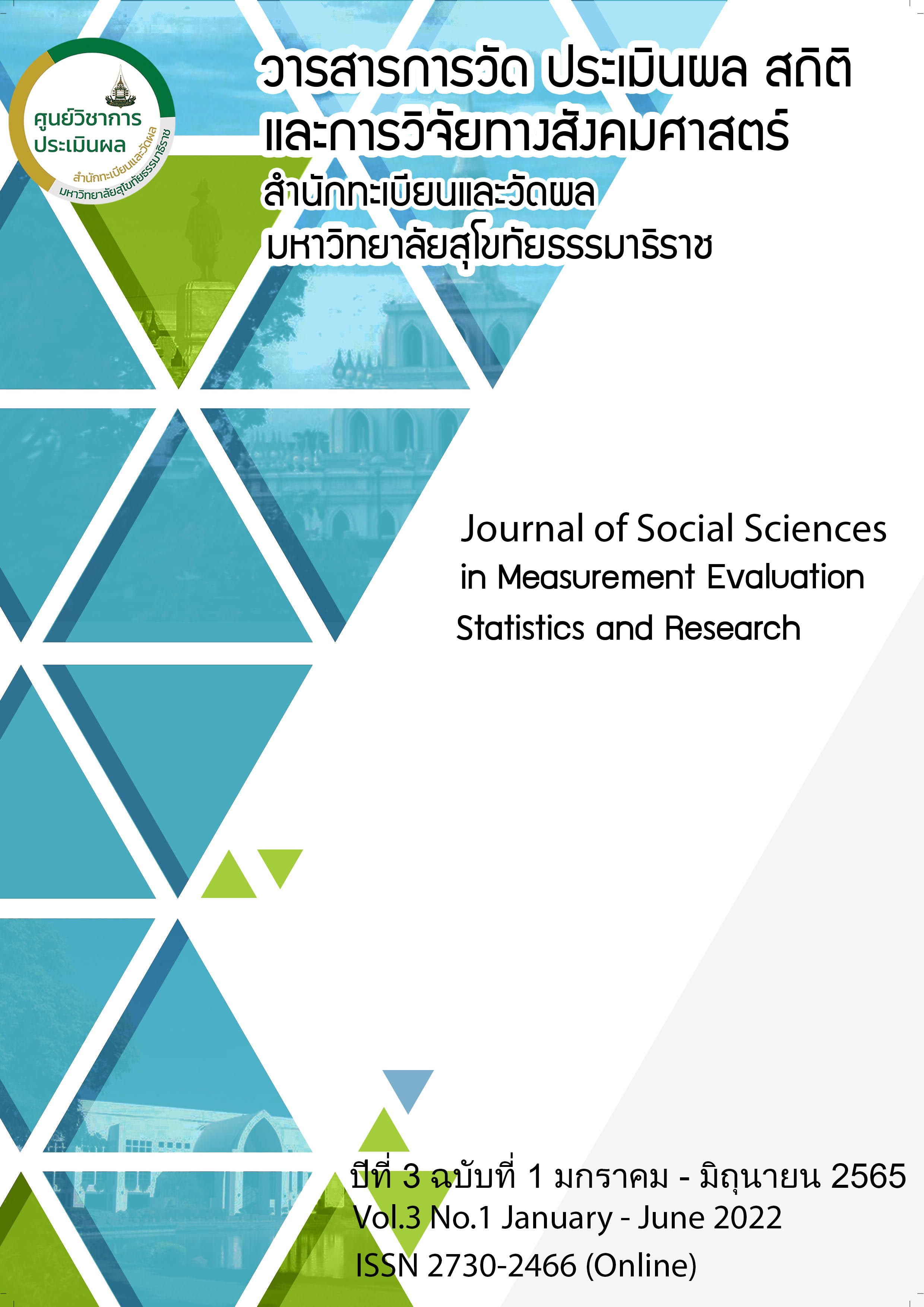Development of an Adult Anxiety Assessment Tool for Naresuan University Students
Main Article Content
Abstract
The objectives of this research are: 1) Create an anxiety assessment tool for Naresuan University students developing into adulthood. 2)Develop and investigate the quality of an anxiety measurement tool in the development of adulthood for Naresuan University students Data were collected from Naresuan undergraduate students in the academic year 2021. The research process consists of the following steps: 1: Interviews with 120 students about the anxiety of developing into adulthood until the data is saturated. 2: Data were collected from 480 students and analyzed by exploratory factor analysis. It was found that 32 of the questions asked had a factor loading of more than 0.05 and were divided into 6 components (i.e., the situation, work, adaptation, occupation, responsibility, and relationships). The third step was to send questions to experts. The results of the Index of Conformity (IOC) analysis with 3 experts were in the range of 0.66 – 1.00, with a total of 32 questions. 4: Collect data for 300 people by stratified sampling method for analyzing the compositional analysis by the researcher and make adjustments to the model to ensure consistency. It was found that the questionnaires could be reduced to 21 questions and consist of 4 components: situation, work, adaptation, and occupation. These were consistent with the empirical data considering the following values (Chi-square =417.51, df =185, CFI = 0.97, NFI = 0.94, RMSEA = 0.85 which passed all the criteria and the instrument generated a confidence value of the whole 0.92. It can be concluded that the Anxiety Assessment Tool is appropriate to be used in the context of Naresuan University students developing into adulthood.
Article Details

This work is licensed under a Creative Commons Attribution-NonCommercial-NoDerivatives 4.0 International License.
ข้อความและบทความในวารสารการวัด ประเมินผล สถิติ และการวิจัยทางสังคมศาสตร์ เป็นแนวคิดของผู้เขียน มิใช่ความคิดเห็นของกองบรรณาธิการวารสาร จึงมิใช่ความรับผิดชอบของวารสารการวัด ประเมินผล สถิติ และการวิจัยทางสังคมศาสตร์ บทความในวารสารต้องไม่เคยตีพิมพ์ที่ใดมาก่อน และสงวนสิทธิ์ตามกฎหมายไทย การจะนำไปเผยแพร่ ต้องได้รับอนุญาตเป็นลายลักษณ์อักษรจากกองบรรณาธิการ
References
ณัฐชา พัฒนา. (2555). ผลของโปรแกรมการสนับสนุนทางสังคมต่อความวิตกกังวลและความพึงพอใจของผู้ป่วยกล้ามเนื้อหัวใจ
ตายเฉียบพลันในหอผู้ป่วยวิกฤต (ปริญญานิพนธ์ปริญญามหาบัณฑิต). มหาวิทยาลัยบูรพา. http://digital_collect. lib.
buu.ac.th/dcms/files/51920307/chapter2.pdf
ทิวาวัลย์ ต๊ะการ, บังอร ฉัตรรุ่งเรือง, เสมอแข สมหอม, และณัฐิยา ตันตรานนท์. (2559). การพัฒนาแบบประเมินมาตรฐานโฮมสเตย์ไทยสำหรับการพัฒนาระบบการให้คำแนะนำ ในการเข้ารับการตรวจประเมินเพื่อให้ได้การรับรองมาตรฐานโฮมสเตย์ไทย, การประชุมวิชาการระดับชาติ มหาวิทยาลัยราชภัฏกำแพงเพชร ครั้งที่ 3 (ฉบับที่ 2) (127-140).
ธีระดา ภิญโญ. (2561). เทคนิคการแปลผลการวิเคราะห์องค์ประกอบสำหรับงานวิจัย. วารสารปัญญาภิวัฒน์, 10, 292-304
นธกฤต วันต๊ะเมล์. (2555). การพัฒนาโมเดลสมการเชิงโครงสร้างการสื่อสารการตลาด เพื่อสังคมเพื่อลดพฤติกรรมเสี่ยงทางสุขภาพของเยาวชนไทย. วารสารจิตพฤติกรรมศาสตร์ : ระบบพฤติกรรมไทย, 9(1-2), 43-62.
มธุรส ผ่านเมืองและ ชนนิกานต์ รอดมรณ์. (2562). การวิเคราะห์องค์ประกอบเชิงสำรวจสำหรับการพัฒนาระบบจัดการความรู้ของคณะบริหารธุรกิจ มหาวิทยาลัยกรุงเทพธนบุรี Exploratory Factors Analysis for Knowledge Management Systems in a Faculty of Business Administration, Bangkokthonburi University. วารสารบริหารธุรกิจและศิลปศาสตร์ ราชมงคลล้านนา, 7(1), 26-38
เมษา นวลศรี, กมลวรรณ ตังธนกานนท์, & โชติกา ภาษีผล. (2560). การพัฒนาเกณฑ์ปกติของ แบบวัดพหุมิติความเป็นพลเมืองที่มีความรับผิดชอบของนักเรียนชั้นมัธยมศึกษาตอนต้น. วารสารบัณฑิตศึกษามหาวิทยาลัยราชภัฏวไลยอลงกรณ์ในพระบรมราชูปถัมภ์, 11(3), 143-155.
สำนักงานสถิติแห่งชาติ. (2564). สรุปผลที่สำคัญการสำรวจสุขภาพจิต (ความสุข) ของคนในประเทศไทย พ.ศ. 2563. กรุงเทพฯ :บางกอกบล๊อก.
สืบตระกูล ตันตลานุกุล, และ ปราโมทย์ วงศ์สวัสดิ์. (2562). การดูแลเฝ้าระวังความเครียดในวัยรุ่น. วารสารเครือข่ายวิทยาลัยพยาบาลและการสาธารณสุขภาคใต้, 6(2), 279-285.
อรรถไกร พันธ์ภักดี. (2559). การเปรียบเทียบผลการใช้สถิติวิเคราะห์ข้อมูล เพื่อตรวจสอบความตรงเชิงโครงสร้างของแบบวัดทุนทางสังคม ระหว่างการวิเคราะห์องค์ประกอบเชิงสำรวจกับการวิเคราะห์องค์ประกอบเชิงยืนยัน. วารสารบริหารธุรกิจ เศรษศาสตร์และการสื่อสาร, 11(2), 46-67
Erikson, E. H. (1968). Identity: Youth and crisis (No. 7). WW Norton & company.
Macek, P., Bejček, J., & Vaníčková, J. (2007). Contemporary Czech emerging adults: Generation growing up in the period of social changes. Journal of Adolescent Research, 22(5), 444-475. https://doi.org/10.1177%2F0743558407305417
Smith, A., Keel, P., Bodell, L., Holm-Denoma, J., Gordon, K., Perez, M., & Joiner, T. (2016). I don’t want to grow up, I’m a Gen X, Y, Me kid : Increasing maturity fears across the decades. International Journal of Behavioral Development, 41(6), 656-661.doi: 10.1177/0165025416654302
Streiner, D.L. & Norman, G.R. (1995). Health measurement scales: A practical guide to their development and use. (2nd ed.). Oxford: Oxford University Press.

